Jiayu Wang
Wan: Open and Advanced Large-Scale Video Generative Models
Mar 26, 2025Abstract:This report presents Wan, a comprehensive and open suite of video foundation models designed to push the boundaries of video generation. Built upon the mainstream diffusion transformer paradigm, Wan achieves significant advancements in generative capabilities through a series of innovations, including our novel VAE, scalable pre-training strategies, large-scale data curation, and automated evaluation metrics. These contributions collectively enhance the model's performance and versatility. Specifically, Wan is characterized by four key features: Leading Performance: The 14B model of Wan, trained on a vast dataset comprising billions of images and videos, demonstrates the scaling laws of video generation with respect to both data and model size. It consistently outperforms the existing open-source models as well as state-of-the-art commercial solutions across multiple internal and external benchmarks, demonstrating a clear and significant performance superiority. Comprehensiveness: Wan offers two capable models, i.e., 1.3B and 14B parameters, for efficiency and effectiveness respectively. It also covers multiple downstream applications, including image-to-video, instruction-guided video editing, and personal video generation, encompassing up to eight tasks. Consumer-Grade Efficiency: The 1.3B model demonstrates exceptional resource efficiency, requiring only 8.19 GB VRAM, making it compatible with a wide range of consumer-grade GPUs. Openness: We open-source the entire series of Wan, including source code and all models, with the goal of fostering the growth of the video generation community. This openness seeks to significantly expand the creative possibilities of video production in the industry and provide academia with high-quality video foundation models. All the code and models are available at https://github.com/Wan-Video/Wan2.1.
EgoVid-5M: A Large-Scale Video-Action Dataset for Egocentric Video Generation
Nov 13, 2024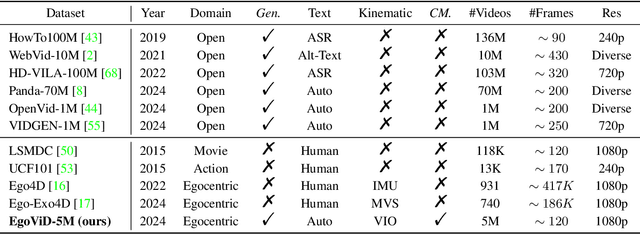
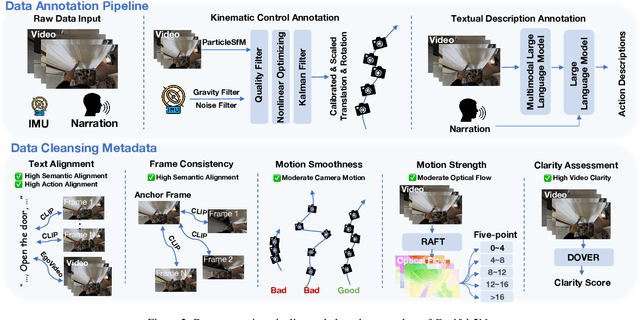

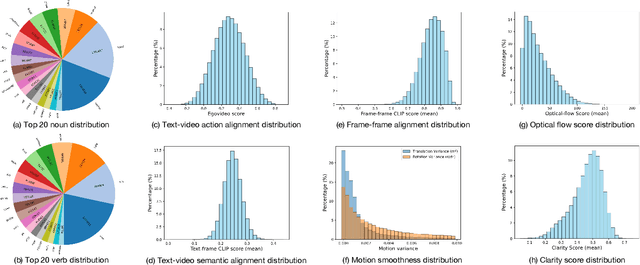
Abstract:Video generation has emerged as a promising tool for world simulation, leveraging visual data to replicate real-world environments. Within this context, egocentric video generation, which centers on the human perspective, holds significant potential for enhancing applications in virtual reality, augmented reality, and gaming. However, the generation of egocentric videos presents substantial challenges due to the dynamic nature of egocentric viewpoints, the intricate diversity of actions, and the complex variety of scenes encountered. Existing datasets are inadequate for addressing these challenges effectively. To bridge this gap, we present EgoVid-5M, the first high-quality dataset specifically curated for egocentric video generation. EgoVid-5M encompasses 5 million egocentric video clips and is enriched with detailed action annotations, including fine-grained kinematic control and high-level textual descriptions. To ensure the integrity and usability of the dataset, we implement a sophisticated data cleaning pipeline designed to maintain frame consistency, action coherence, and motion smoothness under egocentric conditions. Furthermore, we introduce EgoDreamer, which is capable of generating egocentric videos driven simultaneously by action descriptions and kinematic control signals. The EgoVid-5M dataset, associated action annotations, and all data cleansing metadata will be released for the advancement of research in egocentric video generation.
InternLM2.5-StepProver: Advancing Automated Theorem Proving via Expert Iteration on Large-Scale LEAN Problems
Oct 21, 2024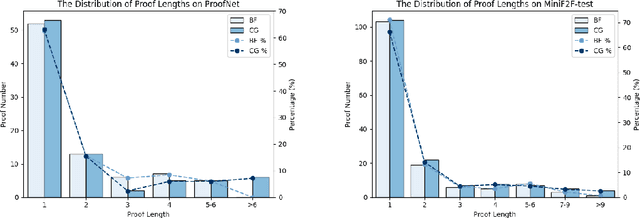

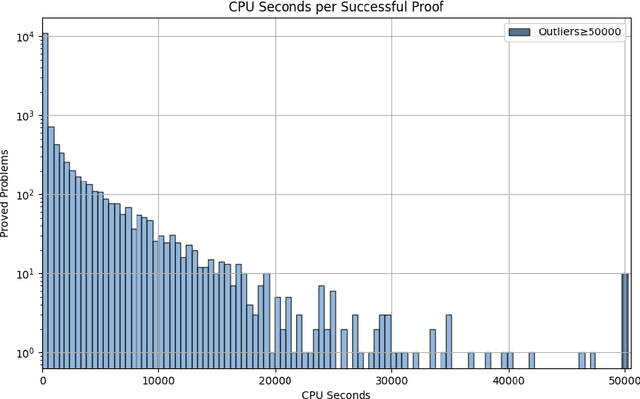

Abstract:Large Language Models (LLMs) have emerged as powerful tools in mathematical theorem proving, particularly when utilizing formal languages such as LEAN. The major learning paradigm is expert iteration, which necessitates a pre-defined dataset comprising numerous mathematical problems. In this process, LLMs attempt to prove problems within the dataset and iteratively refine their capabilities through self-training on the proofs they discover. We propose to use large scale LEAN problem datasets Lean-workbook for expert iteration with more than 20,000 CPU days. During expert iteration, we found log-linear trends between solved problem amount with proof length and CPU usage. We train a critic model to select relatively easy problems for policy models to make trials and guide the model to search for deeper proofs. InternLM2.5-StepProver achieves open-source state-of-the-art on MiniF2F, Lean-Workbook-Plus, ProofNet, and Putnam benchmarks. Specifically, it achieves a pass of 65.9% on the MiniF2F-test and proves (or disproves) 17.0% of problems in Lean-Workbook-Plus which shows a significant improvement compared to only 9.5% of problems proved when Lean-Workbook-Plus was released. We open-source our models and searched proofs at https://github.com/InternLM/InternLM-Math and https://huggingface.co/datasets/internlm/Lean-Workbook.
Scaling Behavior for Large Language Models regarding Numeral Systems: An Example using Pythia
Sep 25, 2024Abstract:Though Large Language Models (LLMs) have shown remarkable abilities in mathematics reasoning, they are still struggling with performing numeric operations accurately, such as addition and multiplication. Numbers can be tokenized into tokens in various ways by different LLMs and affect the numeric operations performance. Currently, there are two representatives: 1) Tokenize into $1$-digit, and 2) Tokenize into $1\sim 3$ digit. The difference is roughly equivalent to using different numeral systems (namely base $10$ or base $10^{3}$). In light of this, we study the scaling behavior of different numeral systems in the context of transformer-based large language models. We empirically show that a base $10$ system is consistently more data-efficient than a base $10^{2}$ or $10^{3}$ system across training data scale, model sizes under from-scratch training settings, while different number systems have very similar fine-tuning performances. We attribute this to higher token frequencies of a base $10$ system. Additionally, we reveal extrapolation behavior patterns on addition and multiplication. We identify that base $100$ and base $1000$ systems struggle on token-level discernment and token-level operations. We also sheds light on the mechanism learnt by the models.
LEAN-GitHub: Compiling GitHub LEAN repositories for a versatile LEAN prover
Jul 24, 2024Abstract:Recently, large language models have presented promising results in aiding formal mathematical reasoning. However, their performance is restricted due to the scarcity of formal theorem-proving data, which requires additional effort to be extracted from raw formal language corpora. Meanwhile, a significant amount of human-written formal language corpora remains underutilized. To address this issue, we propose LEAN-GitHub, a dataset consisting of large-scale formal data extracted from almost all Lean 4 repositories on GitHub. After fine-tuning InternLM-math-plus on this dataset, our model achieved accuracies of 48.8% with a single pass and 54.5% with 64 passes on the Lean 4 miniF2F test, surpassing state-of-the-art method at 52%. And it also achieves state-of-the-art on two other Lean 4 benchmarks (ProofNet and Putnam) targeting different fields/levels of math. These results demonstrate that our proposed dataset is beneficial for formal reasoning on a wide range of math topics. We open-source our model at https://GitHub. com/InternLM/InternLM-Math and our data at https://huggingface.co/ datasets/InternLM/Lean-GitHub
Is A Picture Worth A Thousand Words? Delving Into Spatial Reasoning for Vision Language Models
Jun 21, 2024Abstract:Large language models (LLMs) and vision-language models (VLMs) have demonstrated remarkable performance across a wide range of tasks and domains. Despite this promise, spatial understanding and reasoning -- a fundamental component of human cognition -- remains under-explored. We develop novel benchmarks that cover diverse aspects of spatial reasoning such as relationship understanding, navigation, and counting. We conduct a comprehensive evaluation of competitive language and vision-language models. Our findings reveal several counter-intuitive insights that have been overlooked in the literature: (1) Spatial reasoning poses significant challenges where competitive models can fall behind random guessing; (2) Despite additional visual input, VLMs often under-perform compared to their LLM counterparts; (3) When both textual and visual information is available, multi-modal language models become less reliant on visual information if sufficient textual clues are provided. Additionally, we demonstrate that leveraging redundancy between vision and text can significantly enhance model performance. We hope our study will inform the development of multimodal models to improve spatial intelligence and further close the gap with human intelligence.
Lean Workbook: A large-scale Lean problem set formalized from natural language math problems
Jun 07, 2024Abstract:Large language models have demonstrated impressive capabilities across various natural language processing tasks, especially in solving mathematical problems. However, large language models are not good at math theorem proving using formal languages like Lean. A significant challenge in this area is the scarcity of training data available in these formal languages. To address this issue, we propose a novel pipeline that iteratively generates and filters synthetic data to translate natural language mathematical problems into Lean 4 statements, and vice versa. Our results indicate that the synthetic data pipeline can provide useful training data and improve the performance of LLMs in translating and understanding complex mathematical problems and proofs. Our final dataset contains about 57K formal-informal question pairs along with searched proof from the math contest forum and 21 new IMO questions. We open-source our code at https://github.com/InternLM/InternLM-Math and our data at https://huggingface.co/datasets/InternLM/Lean-Workbook.
UniAnimate: Taming Unified Video Diffusion Models for Consistent Human Image Animation
Jun 03, 2024



Abstract:Recent diffusion-based human image animation techniques have demonstrated impressive success in synthesizing videos that faithfully follow a given reference identity and a sequence of desired movement poses. Despite this, there are still two limitations: i) an extra reference model is required to align the identity image with the main video branch, which significantly increases the optimization burden and model parameters; ii) the generated video is usually short in time (e.g., 24 frames), hampering practical applications. To address these shortcomings, we present a UniAnimate framework to enable efficient and long-term human video generation. First, to reduce the optimization difficulty and ensure temporal coherence, we map the reference image along with the posture guidance and noise video into a common feature space by incorporating a unified video diffusion model. Second, we propose a unified noise input that supports random noised input as well as first frame conditioned input, which enhances the ability to generate long-term video. Finally, to further efficiently handle long sequences, we explore an alternative temporal modeling architecture based on state space model to replace the original computation-consuming temporal Transformer. Extensive experimental results indicate that UniAnimate achieves superior synthesis results over existing state-of-the-art counterparts in both quantitative and qualitative evaluations. Notably, UniAnimate can even generate highly consistent one-minute videos by iteratively employing the first frame conditioning strategy. Code and models will be publicly available. Project page: https://unianimate.github.io/.
Grammar-Aligned Decoding
May 31, 2024Abstract:Large Language Models (LLMs) struggle with reliably generating highly structured outputs, such as program code, mathematical formulas, or well-formed markup. Constrained decoding approaches mitigate this problem by greedily restricting what tokens an LLM can output at each step to guarantee that the output matches a given constraint. Specifically, in grammar-constrained decoding (GCD), the LLM's output must follow a given grammar. In this paper we demonstrate that GCD techniques (and in general constrained decoding techniques) can distort the LLM's distribution, leading to outputs that are grammatical but appear with likelihoods that are not proportional to the ones given by the LLM, and so ultimately are low-quality. We call the problem of aligning sampling with a grammar constraint, grammar-aligned decoding (GAD), and propose adaptive sampling with approximate expected futures (ASAp), a decoding algorithm that guarantees the output to be grammatical while provably producing outputs that match the conditional probability of the LLM's distribution conditioned on the given grammar constraint. Our algorithm uses prior sample outputs to soundly overapproximate the future grammaticality of different output prefixes. Our evaluation on code generation and structured NLP tasks shows how ASAp often produces outputs with higher likelihood (according to the LLM's distribution) than existing GCD techniques, while still enforcing the desired grammatical constraints.
InternLM2 Technical Report
Mar 26, 2024
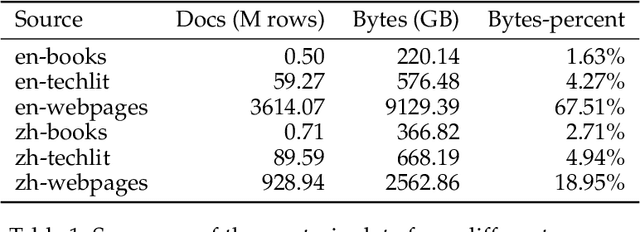
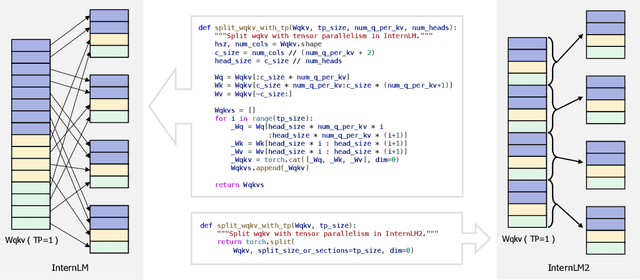

Abstract:The evolution of Large Language Models (LLMs) like ChatGPT and GPT-4 has sparked discussions on the advent of Artificial General Intelligence (AGI). However, replicating such advancements in open-source models has been challenging. This paper introduces InternLM2, an open-source LLM that outperforms its predecessors in comprehensive evaluations across 6 dimensions and 30 benchmarks, long-context modeling, and open-ended subjective evaluations through innovative pre-training and optimization techniques. The pre-training process of InternLM2 is meticulously detailed, highlighting the preparation of diverse data types including text, code, and long-context data. InternLM2 efficiently captures long-term dependencies, initially trained on 4k tokens before advancing to 32k tokens in pre-training and fine-tuning stages, exhibiting remarkable performance on the 200k ``Needle-in-a-Haystack" test. InternLM2 is further aligned using Supervised Fine-Tuning (SFT) and a novel Conditional Online Reinforcement Learning from Human Feedback (COOL RLHF) strategy that addresses conflicting human preferences and reward hacking. By releasing InternLM2 models in different training stages and model sizes, we provide the community with insights into the model's evolution.
 Add to Chrome
Add to Chrome Add to Firefox
Add to Firefox Add to Edge
Add to Edge